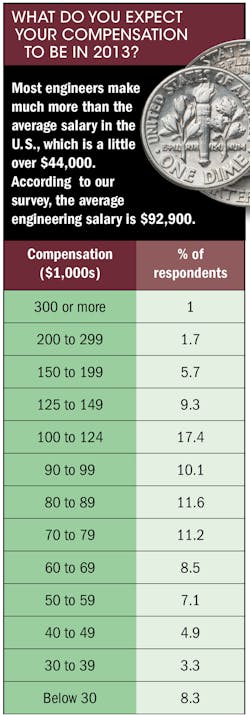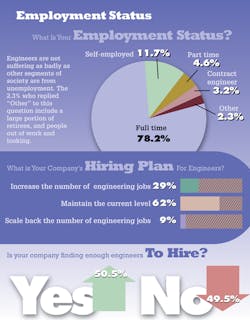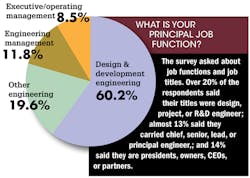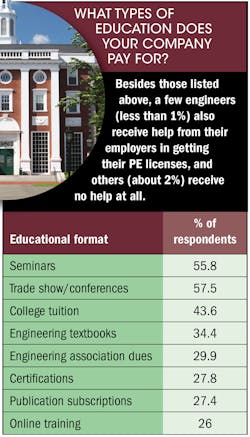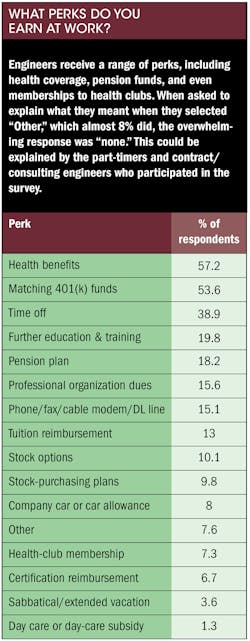But the average bump in salary of 1.57% over last year shows that even engineers continue to feel the effects of an economy trying to rebound.
Compensation
Overall, engineers appear satisfied with their compensation. Almost two-thirds of the survey’s respondents say their companies pay them adequately. But there are always those who want more money.
We asked engineers how large a pay increase it would take before they felt they were fairly paid. Almost one in 10 said it would take a 50% raise, and four out of 10 said the raise would need to be between 6 and 15%. On average, engineers indicated a 20% bump would be fair.
Of course, compensation involves more than just take-home pay. The economy, however, seems to be taking a toll on benefits as well. For example, just 57% of engineers receive health-care benefits. Another benefit that was once widespread is employer-matching of 401(k) contributions. Only 54% of engineers enjoy this perk. Companies offer other retirement-oriented bennies such as stock options (10% of respondents say they have these), stock-purchasing plans (9% have them), and pension plans (18% still have these). In fact, a little more than a quarter of the engineers responding said their company is not funding any part of their retirement.
Other popular perks include time off (39%), educational programs (20%), company-paid dues for professional organizations (16%), and a company-paid phone (15%). One program that does not seem widespread among engineers is day care or a day-care subsidy. Only 1.3% of the respondents claim their employers offer this option. However, it’s possible many respondents are not aware of benefits in this area as only 2.2% of the engineers who filled out the survey are female.
With regards to education, companies support their engineers’ ongoing training in different ways. The two most common are sending engineers to trade shows and conferences, which 58% of respondents take advantage of, and attending seminars, which 56% have access to.
But respondents noted that travel to seminars and trade shows is half of what it was five to 10 years ago.
One reason: Companies apparently put more emphasis on online training, which 26% of the engineers receive. The other two most widespread training practices are aid with college tuition (44%) and reimbursement for engineering textbooks (34%). Only about 4% of engineers say their employers give no assistance with training.
Most of this year’s survey respondents are design engineers (60%), followed by engineering managers (12%), and executive/operational managers (9%). Many in the “Other” category are consultants, educators, field engineers, marketing/sales, QA, or unemployed.
The vast majority of the engineers responding work full time (78%), with about 12% self-employed, 3% contract workers, and almost 5% are part-timers.
When we asked engineers where they put in their time, most said they spent at least 40 hr at the office. Some hard chargers (13%) responded that they’re at the office for 50 or more hours. On the other end of the scale, 12% are at the office for 20 hr or less.
The telecommuting and working-at-home movement doesn’t seem to have gotten much traction in the engineering community. Survey respondents averaged only 9 hr/week working at home, and most of that seems to be in addition to the 40 hr of office time per week. Only 9% of the engineers surveyed spend more than 25 hr at home. And a quarter of engineers say they don’t do any work at home.
Many engineers seem tied to the office when it comes to work. Almost two-third of those responding said they never work outside the office or home, while another 20% indicate they work 5 hr or less outside the office or home. On average, respondents spend about 3 hr doing business “on the road.”
Engineering employment
The survey also tried to get a snapshot of corporate hiring plans. On this front, the engineering profession seems to be doing well. About 30% of respondents say their companies will increase the number of engineering jobs; 60% say the number of engineering jobs at their companies will remain the same; and 10% feel their companies will lay off engineers in the upcoming year.
When asked about their organization’s recruiting efforts, half said their HR departments are having no problem filling slots.
The other half said their companies were struggling to find qualified candidates. When pressed to specify what types of engineers were hard to find, the top three answers were analog-circuit engineers (41%), software engineers (38%), and system engineers (37%).Still, other engineers bemoan the fact the their companies are still laying off, trying to get ever leaner.
For example, one noted that: “Our company has decided, per the CEO, to try to cut 5% of the workforce, based on some book that says 5% of a company’s workforce is underperforming. These gimmicky approaches are cute, but don’t address the real problems and only serve to hurt morale.”
Another observed that management blames layoffs on events like the government “sequester” or layoffs in unrelated industries.
“The slightest black cloud on the horizon results in layoffs, and it’s often referred to as ‘a right-sizing,’’’ says a design engineer.
Another sums up a common complaint: “My company is more interested in obtaining new people than in retaining and retraining existing engineers.” And a managing engineer echoes this sentiment. “The focus is on hiring new people. It seems retention is assumed.”
Overall, 7% of the those taking the survey say they are actively seeking a new position. This number undoubtedly includes many who are out of work.
Among those not looking for new jobs, about 30% would consider taking a position if they heard about an interesting opportunity. And 30% would follow-up on an offer if they were personally approached with an intriguing project or pay raise. There are also a good number (33%) who cannot envision changing jobs in the foreseeable future.
On the bright side for those looking for a new position, a little over half (52%) of the respondents said they were contacted by a headhunter or recruitment specialist within the last year.




